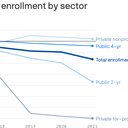Colleges see staggering drop in enrollment, with community colleges hit hardest

The pandemic's effects, along with a decline in the number of young adults, have depressed college enrollment, with community colleges bearing much of the brunt.
Why it matters: A college degree is becoming more important as the demand for higher skills sharpens. The drop in college enrollment — which is especially steep for Black and Latino students — is bad news for both the higher education industry and broader social mobility.
By the numbers: Undergraduate college enrollment overall fell by nearly 5% in the spring of 2021 compared to the year before, according to data recently published by the National Student Clearinghouse.
Details: Two-year community colleges, which typically enroll more low-income students and students of color, were by far the hardest hit, making up more than 65% of the total enrollment losses this spring. (For-profit private universities had a much steeper drop, but enroll far fewer students overall.)
- Community college enrollment dropped by 9.5% this spring, with a loss of 476,000 students.
- Latino enrollment in community colleges overall — which had been increasing before the pandemic — fell by 13.7% this spring, with enrollment of Latino men and Black men falling 19.4% and 21.5% respectively.
- The eroding of community colleges, which serve as a less expensive springboard to the middle class, will "likely be felt for generations," Mamie Voight, the interim president of the Institute for Higher Education Policy, told Inside Higher Ed.
Between the lines: While the effects of the pandemic are the main cause of the drop, college enrollment had been trending downward since 2012.
- Changing demographic patterns that mean fewer college-age adults is a major factor, and one that is set to worsen in the years ahead, which could pose an existential threat to smaller colleges struggling for students.
- Until the pandemic, a gradually strengthening economy was another factor — students are more likely to forego or postpone college when the job market is strong.
- But that also makes the sharp decline in 2020-21 so stark. Higher education usually serves as a refuge during high periods of unemployment, but the opposite happened during the pandemic.
What they're saying: Many of the students who would have gone to community colleges come from low-income and minority backgrounds that were especially hard hit by the pandemic, depriving them of the resources and help they needed, says Mikyung Ryu, director of research publications at the National Student Clearinghouse.
- "If these students do not go to college right after high school or relatively soon after, it's increasingly becoming harder for them to go at all," she adds.
The other side: Even as undergraduate enrollment fell, graduate education is on the rise, with enrollment in master's and doctoral programs rising 5.2% and 3.6% respectively.
- Like other areas of the economy, higher education is taking on a K-shape, with the haves getting more and the have-nots at risk of being left behind.
- "There is a growing divide between undergraduate-level education and graduate level," says Ryu. "And community colleges are by far the worst-hit sector."
What to watch: Rising vaccination rates and changes to the application process — like the growth of standardized test-optional admissions policies — could lead to a bounce back in the fall.
The bottom line: With the job market suddenly surging, the lack of a college degree may seem to matter less at the moment.
- But a college degree of any kind remain one of the best protections against unemployment, and those who miss out now could end up in what Ryu calls the "lost opportunity generation."